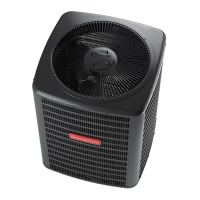What to do if Goodman GSC13030 has too much air across indoor coil?
- RRobert NguyenSep 23, 2025
If there is too much air across the indoor coil of your Goodman Air Conditioner, reduce the blower speed.
What to do if Goodman GSC13030 has too much air across indoor coil?
If there is too much air across the indoor coil of your Goodman Air Conditioner, reduce the blower speed.
What to do if Goodman GSC13030 has overcharge of refrigerant?
If you have an overcharge of refrigerant in your Goodman Air Conditioner, recover part of the charge.
How to fix loose connection in Goodman Air Conditioner?
If your Goodman Air Conditioner has a loose connection, inspect the connection and tighten it.
How to test shorted or broken wires in Goodman GSC13030?
If your Goodman Air Conditioner has shorted or broken wires, test the circuits with an ohmmeter.
What to do if Goodman Air Conditioner has noncondensibles?
If your Goodman Air Conditioner has noncondensibles, recover the charge, evacuate, and recharge.
What to do if Goodman Air Conditioner has not enough air across indoor coil?
If there is not enough air across the indoor coil of your Goodman Air Conditioner, increase the blower speed and check the duct static pressure.
What to do if Goodman GSC13030 has undersized liquid line?
If the liquid line is undersized in your Goodman Air Conditioner, replace the line.
What to do if Goodman GSC13030 has undersized suction line?
If the suction line is undersized in your Goodman Air Conditioner, replace the line.
How to test faulty fan relay in Goodman GSC13030 Air Conditioner?
If your Goodman Air Conditioner has a faulty fan relay, test the continuity of the coil and contacts.
How to test shorted or grounded compressor in Goodman GSC13030 Air Conditioner?
If your Goodman Air Conditioner compressor is shorted or grounded, test the motor windings.
Connect gauge manifold to service ports and run system for 10 minutes.
Install thermometer on suction line near valve for accurate reading.
Use superheat table to adjust refrigerant charge for optimal performance.
Disconnect all power before servicing to prevent severe injury or death.
Ensure installation complies with national, local codes, and EPA regulations.
Maintain specified clearances for airflow and consider installation location factors.
Follow guidelines for safe handling of refrigerants to prevent hazards.
Understand hazards like weight, cold temperature, and cylinder safety for proper handling.
Use approved cylinders, avoid damage, and adhere to pressure ratings for safety.
Prevent line contact with structures and insulate the suction line for performance.
Refer to the table for recommended refrigerant line sizes based on system capacity.
Insulate suction and liquid lines and protect underground portions.
Follow brazing guidelines, use correct heat, and protect components.
Perform leak testing using dry nitrogen and soapy water or a detector.
Avoid using oxygen, air, or flammable gases; use pressure regulator for nitrogen.
Evacuate system to 250 microns or less and hold for 10 minutes.
Open service valves, connect pump, evacuate, and hold vacuum.
Disconnect all power before servicing; ensure wiring conforms to codes.
Use copper conductors and size wires to limit voltage drop to 2%.
Open service valves carefully to avoid refrigerant leaks.
Add refrigerant amount as shown in the table after evacuation.
Adjust refrigerant charge using superheat table after system stabilization.
Adjust TXV for superheat and subcooling based on system type.
Connect gauge manifold to service ports and run system for 10 minutes.
Install thermometer on suction line near valve for accurate reading.
Use superheat table to adjust refrigerant charge for optimal performance.
Disconnect all power before servicing to prevent severe injury or death.
Ensure installation complies with national, local codes, and EPA regulations.
Maintain specified clearances for airflow and consider installation location factors.
Follow guidelines for safe handling of refrigerants to prevent hazards.
Understand hazards like weight, cold temperature, and cylinder safety for proper handling.
Use approved cylinders, avoid damage, and adhere to pressure ratings for safety.
Prevent line contact with structures and insulate the suction line for performance.
Refer to the table for recommended refrigerant line sizes based on system capacity.
Insulate suction and liquid lines and protect underground portions.
Follow brazing guidelines, use correct heat, and protect components.
Perform leak testing using dry nitrogen and soapy water or a detector.
Avoid using oxygen, air, or flammable gases; use pressure regulator for nitrogen.
Evacuate system to 250 microns or less and hold for 10 minutes.
Open service valves, connect pump, evacuate, and hold vacuum.
Disconnect all power before servicing; ensure wiring conforms to codes.
Use copper conductors and size wires to limit voltage drop to 2%.
Open service valves carefully to avoid refrigerant leaks.
Add refrigerant amount as shown in the table after evacuation.
Adjust refrigerant charge using superheat table after system stabilization.
Adjust TXV for superheat and subcooling based on system type.
| Tonnage | 2.5 Tons |
|---|---|
| SEER Rating | 13 |
| Compressor Type | Scroll |
| Refrigerant Type | R-410A |
| Voltage | 208/230 V |
| Maximum Overcurrent Protection | 25 Amps |
| Sound Level (Outdoor Unit) | 74 dB |
| Cooling Capacity | 30, 000 BTU/h |
| Phase | 1 |












